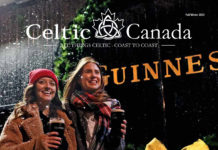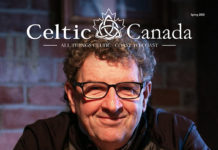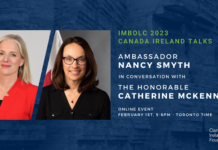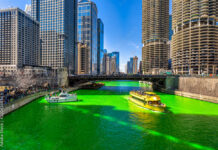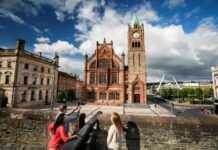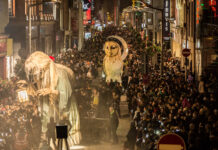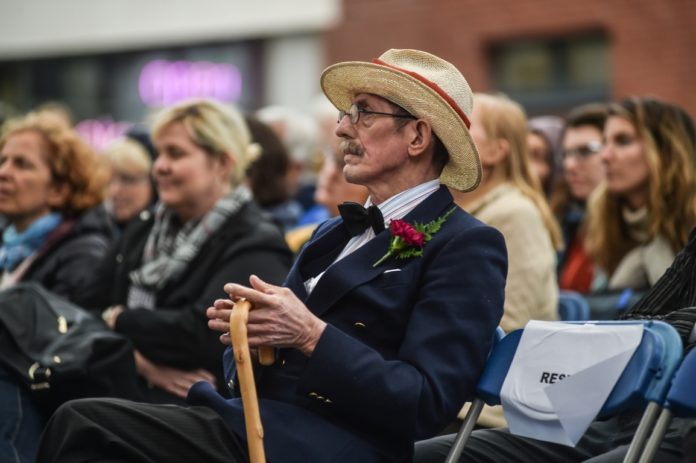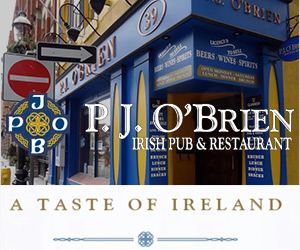Daniel Mulhall is Ireland’s Ambassador to the United States shares his Ulysses Blog with us…a very enjoyable read!
I first heard tell of James Joyce’s Ulysses when I was at Secondary School at Mount Sion CBS in Waterford around the year 1970. A teacher known for his radical views recommended it to a group of his pupils and some of the more adventurous readers among us (and I was not one of them) may even have dipped into what we were warned was a controversial masterpiece, the kind of book we probably should not tell our parents, or the Brothers at school, that we were reading.
At University in Cork, the undergraduate curriculum in English did not include Ulysses although we did study A Portrait of the Artist as a Young Man, whose Christmas dinner scene during which a flaming row develops about the rise and fall of the late 19th century Irish political titan, Charles Stewart Parnell, was the subject of an undergraduate essay I wrote on the overlap between history and literature. That topic has been an enduring interest of mine ever since.
It was the summer of 1974 before I acquired a copy of Ulysses. I bought it at the bookshop at the University of Missouri, Kansas City (UMKC) across the street from Rockhurst College where I stayed during the three months I spent in America on a J1 student visa. That American edition of Ulysses, which I still possess, contains the text of the judgement delivered by a New York judge, John M. Woolsey, on December 6, 1933, when he lifted the ban on the book and paved the way for its publication in the United States. Morris L. Ernst, the attorney who represented Joyce and his publishers, Random House, greeted the judgement by stating that “the New Deal in law and letters has just arrived”. Judge Woolsey described Joyce’s novel as “an amazing tour de force” which, on account of its style and literary ambition, could not be considered obscene.
I was reminded of that landmark ruling while reading Joseph M. Hassett’s excellent recent book The Ulysses Trials: Beauty and Truth Meet the Law, which tells the story of the legal shenanigans that preceded the book’s publication in the United States.
Looking back, I confess that I made limited headway with Ulysses during the summer of 1974 and years were to pass before I came to grips with its magnificent scope, its encyclopaedic insights and its tightly-packed yet luminous prose. During my time in India in the early 1980s, I gave a paper on Joyce at the All-India English Teachers Association Annual Conference during which I concentrated on A Portrait. My experiences in India made me appreciate the value to Ireland of our rich literary heritage and how it has served to make Ireland better known internationally than it could otherwise hope to be.
It was when I arrived in Scotland in 1998, however, that my engagement with Ulysses began in earnest. In June 1999, I hosted my first Bloomsday at the Consulate in Edinburgh and I can still remember the Irish academic, Owen Dudley-Edwards’ magnificent reading from the Cyclops episode featuring Joyce’s hyperbolic description of ‘the Citizen’ and his litany of “many Irish heroes and heroines of antiquity”. That rollicking passage has become a staple of mine during a succession of Bloomsday events I have hosted over the years in Kuala Lumpur, Berlin and London.
What has always intrigued me about James Joyce is the fact that, although he left Ireland at the tender age of 22 and returned home just twice during the 37 years he spent living in continental Europe, all of his great work is centred in the Dublin from which he departed in 1904. And while Joyce described early 20th century Dublin as a ‘centre of paralysis’ he felt compelled to leave in search of artistic freedom, in reality it remained for him a potent source of inspiration. By all accounts, he pressed visiting Irish people for updates on his home city and once said that he wanted “to give a picture of Dublin so complete that if the city suddenly disappeared from the earth it could be reconstructed out of my book.”
What was it about early 20th century Dublin that spurred James Joyce to write the greatest modern novel in the English language? That’s what I would like to know and don’t yet fully understand. Early 20th century Ireland has always been a source of fascination for me. That era was the subject of my book, A New Day Dawning: a Portrait of Ireland in 1900 (Cork 1999) and of a collection of essays I co-edited in 2016, The Shaping of Modern Ireland: a Centenary Assessment (Dublin 2016).
The years between the death of Parnell in 1891 and the foundation of the Irish Free State in 1922 formed the most productive period in modern Irish history, giving birth as it did to a new Irish State but also to a raft of literary achievements. The city and the country Joyce left behind in the opening years of the 20th century was home to a diverse batch of writers, artists, cultural revivalists, nationalist activists and would-be revolutionaries.
Some of the greatest figures in modern Irish history were born in the last third of the 19th century and were coming into their own around the turn of the century, among them WB Yeats, Patrick Pearse, James Connolly, Thomas MacDonagh, Eamon de Valera, Michael Collins, Constance Markievicz, Eva Gore-Booth, Arthur Griffith, Douglas Hyde and Joyce himself. They all lived, or spent some time in the city Joyce fled in 1904 equipped with an iron resolve “to forge in the smithy of my soul the uncreated conscience of my race”.
And Ulysses offers us an extraordinary portrait of Dublin and its people, a people on the verge of undertaking a remarkable journey of political change that transformed Ireland from a disenchanted part of the United Kingdom into the independent state that emerged in 1922. Moreover, Irish independence came about in the teeth of determined opposition from what was at that time still the world’s most powerful country.
The years following the First World War were turbulent ones across Europe and a number of new states were born – Poland, Hungary, Czechoslovakia among others – but those countries emerged from the ruins of Europe’s defeated Empires. Ireland was an exception in the fact that it prised itself free from one of the First World War’s victorious powers.
In that sense, Ireland blazed a trail that many others would follow in the years after World War 2 when the European Empires were no longer able to hold on to their African and Asian possessions. It can be argued, therefore, that Ireland was the first modern State. And that brings me back to Joyce’s Ulysses.
The Irish Free State came into being following the Anglo-Irish Treaty of 1921. The symbolic transfer of power to Ireland’s new Provisional Government took place on 16 January. It was on that date that Dublin Castle was handed over to Michael Collins by the Lord Lieutenant of Ireland. And a little over a fortnight later, on the 2nd of February, on another date rich in symbolism as it was Joyce’s 40th birthday, Ulysses was published in Paris.
In less than four years from now, we will mark the centenary of Irish independence – the birth of the first modern State – and also the centenary of the publication of the first great modernist novel. As someone who has represented Ireland around the world for almost four decades that conjunction stirs my imagination.
This may be a foolhardy venture, but I plan to prepare for the Ulysses centenary by writing over the next few years a series of blogs, one on each episode of that great novel. By the time I have finished this venture, I hope to have achieved a more complete understanding of Joyce’s novel and of the Ireland that inspired it.
I freely admit that I am not a Joyce scholar and there are many who know Ulysses far better than I do, but that may turn out to be an advantage as I try to share my understanding of Joyce’s great work with others who are searchers rather than scholars. My qualification as a Joycean, if I have one, comes from the fact that I have carried Joyce around the world with me for close to 40 years and have written and spoken about him umpteen times in India, Australia, Scotland, Malaysia, Thailand, Vietnam (where I once launched a Vietnamese translation of A Portrait), Germany, England and the United States. I hope that those experiences of explaining Joyce to people in different countries, and my enthusiasm for early 20th century Ireland, will carry me through. Only time will tell!
Daniel Mulhall is Ireland’s Ambassador to the United States.





